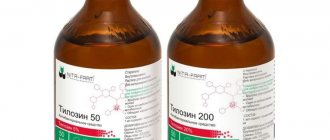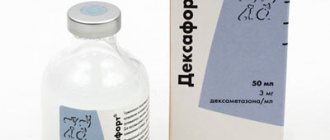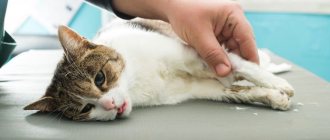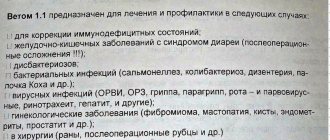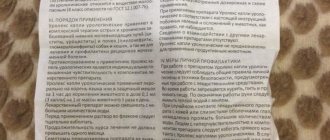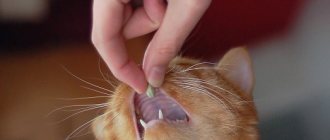“Papaverine” for cats: use with caution
For some acute diseases, cats are prescribed broad-spectrum antispasmodics, which are highly effective and relieve all inflammatory processes.
This is exactly what the drug “Papaverine” is, which has now become very widespread. It reduces the tone and activity of muscle tissue. This happens due to vasodilation. Due to the action of the drug, it is possible to eliminate the spasm and get rid of the pain syndrome. But is the drug really that good? Does it have any nuances and contraindications? Read about this and much more in our article.
Pharmaceutical forms of “Papaverine” for cats
There are three forms of drug release:
- an injection solution, the antispasmodic effect of which lasts from six to eight hours, is packaged in glass ampoules of two milliliters, and ten such ampoules are placed in one box;
- tablets are used less frequently due to the fact that their analgesic effect occurs very slowly, packaged in 40 mg in separate packages;
- rectal suppositories (twenty milligrams each) are used if it is not possible to administer an injection and it is not possible to give the animal a pill.
Well
The course of treatment is always determined only by the attending veterinarian. The duration of medication depends on many factors, the main of which is the stage of the disease and its complexity. Typically, the course of use of the drug does not exceed seven days, but there are also more advanced cases when the period of taking the drug is increased.
Possibility of overdose
Important!
You cannot use “Papaverine” without consulting and prescribing a veterinarian!
Due to incorrect calculation of the volume of the drug per animal weight, an overdose may occur. Its consequences may be:
- loss of vision (temporary or permanent);
- arrhythmia;
- disturbances in vision (double vision);
- headache, nausea;
- paresis of the hind limbs;
- strong sedative effect;
- decreased excitability of the heart muscle.
In case of overdose, you must immediately stop using the drug and remove it from the body as quickly as possible and ensure that blood pressure is maintained. Gastric lavage (when taking pills) and enterosorbents are prescribed. Do not let the animal eat until it has been examined by a specialist.
You can watch a video on how to inject a cat subcutaneously (at the withers):
Conclusion
The drug “Papaverine” for cats quickly and effectively relieves pain by relaxing all organs without exception. Its action is more delicate than any other drugs in the same series.
But, despite all its advantages, you cannot use any dosage form of the drug without a veterinarian’s prescription.
Be sure to consult a doctor and under no circumstances self-medicate as this could cost your pet’s life.
Pharmaceutical forms of “Papaverine” for cats
There are three forms of drug release:
- an injection solution, the antispasmodic effect of which lasts from six to eight hours, is packaged in glass ampoules of two milliliters, and ten such ampoules are placed in one box;
- tablets are used less frequently due to the fact that their analgesic effect occurs very slowly, packaged in 40 mg in separate packages;
- rectal suppositories (twenty milligrams each) are used if it is not possible to administer an injection and it is not possible to give the animal a pill.
When is it appointed?
The medicine is used for various diseases of the gastrointestinal tract and genitourinary system.
For intestinal colic
After eating heavy food, pain in the stomach or intestines may occur, due to which the animal cannot find a place for itself and attracts the owner’s attention by meowing. In this case, you can help your pet by giving him orally a Papaverine tablet, which will relax the smooth muscles of the intestines and relieve spasms.
Papaverine copes well with pain and spasms of smooth muscle fibers in cats, but is an extremely dangerous drug
For pathologies of the digestive system
Problems of the digestive system can be solved with the help of suppositories, which will most quickly provide relief from painful symptoms. In this case, the animal will have to either be held tightly or the introduction done quickly. Disorder of the gastrointestinal tract requires quick intervention, which can be provided by rectal suppositories.
Important! You can also use rectal suppositories for further treatment, so as not to frighten the cat and not cause her a painful shock from the injection.
For infectious diseases of the genitourinary system
Infections due to urinary retention or other diseases of the genitourinary system are treated with radical intervention, when it is impossible to hesitate, and the pet’s health and life are at risk. In such cases, “Papaverine” is used in injections. The injection is made at the withers, and to make it, the animal is taken by the scruff of the neck and held firmly until the end of the drug administration.
For cystitis
If your pet meows pitifully when visiting the litter box, it may have cystitis. This disease often manifests itself in adult animals and is accompanied by difficulty urinating and pain. Here, too, the fastest and most effective method is injection under the withers.
We recommend reading about the drug “Stop Cystitis” for cats.
With pylorospasm
Sphincter spasm is not the most common disease in cats, but it does happen sometimes. Obviously, it is necessary to relieve symptoms of pain locally, using rectal suppositories. They must be inserted very carefully and the pet must be held for a while so that the candles do not fall out when moving.
In addition to suppositories, you can add tablets to food, because suppositories can leak when the inflamed sphincter contracts.
For cholecystitis
Cholecystitis is treated with the complex use of medications. “No-shpa”, “Papaverine” or its analogues are injected. All this is introduced to quickly relieve pain from spasms that can debilitate your pet. In the future, when the spasms disappear, you can begin targeted therapy for urolithiasis and gallstone diseases.
Side effects
Side effects in dogs may include:
- allergic reaction (itching, skin rashes);
- nausea;
- eosinophilia;
- drowsiness;
- dizziness (manifested through lack of coordination);
- constipation;
- decreased blood pressure;
- sweating;
- AV block;
- tachycardia.
If the dosage of the drug is exceeded, the following symptoms appear:
- weakness (the dog constantly lies down and stops playing);
- headache;
- visual impairment (the animal may crash into walls).
If injections are administered incorrectly or too quickly, heart rhythm disturbances may occur.
If any symptom appears, you must immediately stop taking the medicine. The animal should be shown to a specialist. Enterosorbents and drugs that increase blood pressure are usually prescribed.
If it is not possible to visit a veterinarian in the near future, it is necessary to give the dog a gastric lavage. To do this, use warm boiled water. You can add a few manganese crystals to it (until it turns light pink). Do not feed the animal before going to the veterinary clinic.
The combined use of papaverine and barbiturates is not recommended. If at the time of the doctor’s prescription you are already giving your pet other medications, you must notify the specialist about this.
Possibility of overdose
Important!
You cannot use “Papaverine” without consulting and prescribing a veterinarian!
Due to incorrect calculation of the volume of the drug per animal weight, an overdose may occur. Its consequences may be:
- loss of vision (temporary or permanent);
- arrhythmia;
- disturbances in vision (double vision);
- headache, nausea;
- paresis of the hind limbs;
- strong sedative effect;
- decreased excitability of the heart muscle.
In case of overdose, you must immediately stop using the drug and remove it from the body as quickly as possible and ensure that blood pressure is maintained. Gastric lavage (when taking pills) and enterosorbents are prescribed. Do not let the animal eat until it has been examined by a specialist.
Indications and contraindications for use
The medicine is prescribed to cats in the following cases:
Intestinal colic and acute pain caused by various pathological conditions
Often, after eating a heavy meal, the cat suffers from pain and tries to attract the owner’s attention by meowing. Papaverine tablet helps relax muscles and relieve spasms. Diseases of the genitourinary system caused by infections
Urinary retention can lead to negative consequences, so you should not hesitate. In such cases, veterinarians recommend Papaverine injections. Cystitis of any origin, incl. started due to hypothermia of the pet. Pylorospasm (sphincter spasm). This pathology is not common in cats. Candles will help relieve pain. Cholecystitis. Spasms that occur during cholecystitis exhaust animals. It is necessary to relieve the pain as soon as possible. This is done using injections.
Most often, the drug is prescribed as part of complex therapy along with medications that eliminate the cause of the pathology.
Contraindications to taking Papaverine:
- liver failure;
- problems with the adrenal glands;
- shock or stress of the pet;
- age up to 6 months;
- individual intolerance to the components included in the drug.
Contraindications
Tablets and other dosage forms of Papaverine cannot be used to treat cats in the following cases:
- for glaucoma;
- with liver failure;
- in case of dysfunction of the adrenal glands;
- in a state of shock;
- under severe stress;
- for brain injuries;
- with renal failure.
The medicine should be used with caution if you have tachycardia or other heart problems, as well as with low blood pressure. In this case, the animal must be under the supervision of a veterinarian throughout the entire treatment. The medicine is also contraindicated in case of individual intolerance.
Important! The medicine should not be used on kittens under 6 months of age.
Indications for use of the drug
Despite the fact that the drug is prescribed to people (according to the instructions), it is also used in the complex treatment of animals. In cats, the medication is indicated for the following disorders:
- with urolithiasis;
- infections of the reproductive and urinary systems;
- cholecystitis;
- bronchial spasms;
- digestive pathologies, which are accompanied by severe painful sensations;
- colic in the intestines, provoked by infectious lesions and other factors;
- cystitis caused by bacteria and other reasons.
In addition, the product is used in cats for urine retention to relieve pain and spasms. Thanks to the influence of the medicine, the urinary ducts and bladder are weakened, so the emptying process is faster and easier.
A post shared by WhatsApp 0079193424903 (@drracevet) on Jan 17, 2018 at 4:02am PST
Most often, this antispasmodic is used in combination with other medications aimed at eliminating the cause of the disease. A veterinarian should prescribe complex treatment.
Description and characteristics
The action of the drug is based on the mechanism of suppressing ovulation, and therefore the impossibility of conception. This is achieved due to the fact that, under the influence of the active substance of the drug, the egg does not leave the follicle.
Did you know? Estrogen is a female sex hormone. It is believed that it is responsible for feminine traits (softness, participation, rounded body shapes). In contrast, testosterone is a male hormone (brutality, brute strength). Both of them are produced by both male and female bodies, only in different proportions. Moreover, the structure of both hormones is almost identical.
Such drugs have a fairly large number of side effects (largely for this reason, their use in medical practice is strictly regulated), which include disruption of normal hormonal levels. So if the birth of kittens is not planned at all, it is more advisable to sterilize the cat, since frequent use of such drugs increases the risk of developing oncology and some other diseases, as will be discussed below.
Indications for use of the drug
The drug is widely used for:
- spasms of smooth muscles;
- urinary system infections;
- intestinal colic;
- diseases of the gastrointestinal tract;
- urinary tract spasms;
- cholecystitis;
- pylorospasm;
- to lower blood pressure.
Sometimes it is prescribed to animals that suffer from bronchospasm and spasm of peripheral vessels. The medicine can solve a number of problems that arise during illnesses. It helps relax the muscles and walls of the bladder, uterus, bronchi and many other organs.
Sometimes an injection of “Papaverine” is administered before any surgical intervention or urological manipulation, as well as to relieve acute pain during the treatment of urolithiasis.
The advantage of using this drug is the painlessness of injections and the rapid distribution of the active substance in the tissues, which helps to quickly relieve pain. The injection is not painful and does not cause anxiety or discomfort in the cat.
How it works
The medication has an antispasmodic effect, that is, the ability to eliminate spasms. The drug also relieves pain that accompanies spasms and lowers blood pressure. The effect of the drug is due to the fact that the active substance blocks the synthesis of enzymes, as a result of which the tone of the smooth muscles that make up the stomach, bladder, kidneys and other internal organs decreases.
When smooth muscle tone is greatly increased, a spasm occurs, which is usually accompanied by acute pain. Under the influence of Papaverine, the muscles of the internal organs relax and tone decreases. The medicine also helps to dilate blood vessels, thereby achieving a hypotensive effect (lowering blood pressure). The drug also has a calming effect on the central nervous system. In this regard, when using Papaverine, animals become calmer and stop showing anxiety.
Note! The drug can affect cardiac activity, so it is strictly prohibited to use it for pets without a veterinarian’s prescription.
Papaverine for cats: indications and instructions for use, reviews, price
Papaverine is an affordable medication often used in cats for spasms and severe pain.
The human drug is highly effective, therefore it is successfully used in veterinary medicine to eliminate symptoms of cystitis, urolithiasis and other pathologies.
The medication is produced by different pharmacological companies and can be easily purchased at any pharmacy.
general description
The antispasmodic is produced in several dosage forms:
- Injection
. The transparent liquid is packaged in sealed glass ampoules. Some manufacturers use bottles with a plastic cap. They are considered more convenient to use, since there is no risk of injury from glass when opening. 1 ml of solution usually contains 20 mg of papaverine hydrochloride. The composition also includes purified water and other components. - Pills
. Round white tablets are packaged in contour cells of 10 pieces. In pharmacies they come in two dosages - one tablet may contain 10 or 40 mg of the active substance. In addition, the composition includes potato starch, talc, stearic acid and other components that perform exclusively an auxiliary function. - Rectal suppositories
. Small candles are packaged in PVC plates. The concentration of the active substance in them is 20 mg. Excipients are solid fat, emulsifier and cosmetic stearin.
For cats, Papaverine is most often used in injections. The solution is quick-acting, but the tablets are less effective. The active substance included in their composition “works” on the body only half (bioavailability is only 54%). Candles for animals are used in rare cases.
How it works
The medication has an antispasmodic effect, that is, the ability to eliminate spasms. The drug also relieves pain that accompanies spasms and lowers blood pressure.
The effect of the drug is due to the fact that the active substance blocks the synthesis of enzymes, as a result of which the tone of the smooth muscles that make up the stomach, bladder, kidneys and other internal organs decreases.
When smooth muscle tone is greatly increased, a spasm occurs, which is usually accompanied by acute pain. Under the influence of Papaverine, the muscles of the internal organs relax and tone decreases.
The medicine also helps to dilate blood vessels, thereby achieving a hypotensive effect (lowering blood pressure). The drug also has a calming effect on the central nervous system.
In this regard, when using Papaverine, animals become calmer and stop showing anxiety.
Note! The drug can affect cardiac activity, so using it on pets without a veterinarian’s prescription is strictly prohibited.
When is it appointed?
The instructions for use for the drug are written for people, but Papaverine is used for cats for similar problems. It is usually prescribed:
- for intestinal colic caused by infections and other factors;
- with pathologies of the digestive system accompanied by acute pain;
- for infectious diseases of the genitourinary system;
- for cystitis caused by hypothermia, pathogenic bacteria and other factors;
- with pylorospasm;
- with cholecystitis;
- for bronchospasm, etc.
Also, the medicine is often used for cats and kittens with urolithiasis and urinary retention caused by other factors. The drug is prescribed to eliminate spasms, pain and other similar symptoms.
For example, for urolithiasis or cystitis, Papaverine is injected into cats to eliminate urinary retention.
Under the influence of the drug, the bladder and ducts relax, so the animal begins to go to the toilet on its own.
In most cases, the antispasmodic is combined with other drugs, the action of which is aimed at eliminating the cause of the pathology, and not the symptoms. A veterinarian should select complex therapy.
Note! Papaverine has a number of contraindications and can cause side effects if used incorrectly. In this regard, its use on animals is allowed only as prescribed by a doctor.
Price
Some people choose Papaverine to treat cats because of its price. The cost of one 2 ml ampoule starts from 5 rubles, and a package of tablets from 15 rubles. The drug is available in all human pharmacies, so there is never any difficulty in finding it when purchasing.
You can now view the current price of the drug and buy it right here:
How to use
The dosage of the drug is calculated depending on the weight of the animal.
Regardless of whether tablets or injections are used, 1-2 mg of the active substance is needed for every kilogram of the pet’s weight, but the doctor must calculate the exact dose, taking into account the severity of the disease and other factors.
The medicine is taken 1-2 times a day. The duration of treatment is determined by the doctor depending on the general state of health, the characteristics of the disease, etc.
Important! The course of use of the antispasmodic should not exceed 7 days. Only in rare cases and under strict medical supervision is longer use allowed.
Injections
Papaverine is usually injected subcutaneously into cats. To do this, you need to pull back the fold of skin at the withers, pierce it with a sterile needle on a syringe and slowly inject the medicine. The injection is easy to administer, which is why most pet owners do it. It is better to use an insulin syringe for the injection. It is equipped with a thin needle, which will make it easier to pierce the thick skin on the cat's withers.
Intramuscular administration of the drug is also allowed. With this method, injections can be painful, since discomfort occurs when the needle or solution hits a nerve fiber. In the absence of appropriate skills, this problem is common.
Tablets and suppositories
The tablets can be hidden in food, but they have a bitter taste, so cats often spit them out. In this regard, it is best to give the drug forcibly. To do this, the tablets need to be placed on the root of the tongue, keeping the pet's head elevated. Usually the medicine in this form is given both in the morning and in the evening.
Suppositories are inserted into the anus according to the instructions for use, but this dosage form is used extremely rarely for animals.
Contraindications
Tablets and other dosage forms of Papaverine cannot be used to treat cats in the following cases:
- for glaucoma;
- with liver failure;
- in case of dysfunction of the adrenal glands;
- in a state of shock;
- under severe stress;
- for brain injuries;
- with renal failure.
The medicine should be used with caution if you have tachycardia or other heart problems, as well as with low blood pressure. In this case, the animal must be under the supervision of a veterinarian throughout the entire treatment. The medicine is also contraindicated in case of individual intolerance.
Important! The medicine should not be used on kittens under 6 months of age.
Possible side effects
The antispasmodic can cause the following side effects in cats:
- nausea and vomiting (when using tablets, increased salivation may also occur);
- drowsiness and lethargy;
- heavy sweating;
- lowering blood pressure;
- heart rhythm disturbances;
- constipation
Since the medication affects the central nervous system, temporary loss of hearing or vision and decreased concentration may occur. The risk of side effects increases when the dose is exceeded, so consultation with a doctor before use is required.
Owner reviews
Nina, owner of a 3-year-old cat:
“When our cat Timofey grew up, he had to be neutered, since there are two other cats living in the house. After a while, he was diagnosed with urolithiasis and treated, quite effectively.
A couple of months later, an attack occurred - the cat could not go to the toilet, and when it did, there was blood in the urine. I had to go to the clinic again. The doctor prescribed Papaverine and other medications.
After just a couple of days the cat felt much better. Problems with urination are now a thing of the past.”
Dmitry, owner of a Persian cat:
“My cat never goes outside; at most she can walk on the windowsill. Despite this, I contracted cystitis somewhere. I noticed that it sits in the tray for a long time, and only a couple of drops come out. The first time they drained urine using a catheter, then they started injecting Papaverine. The cat felt better and began to urinate on its own. The drug is cheap and effective.”
Reviews from veterinarians
Elena, veterinarian from the Avet clinic:
“Papaverine is a universal medicine that should be in the medicine cabinet in every home. It is good for both people and animals. Most often I prescribe it for problems with urination, although sometimes it helps relieve symptoms of pancreatitis and other problems of the digestive system.”
Andrey, veterinarian with 12 years of experience:
“Although papaverine is a human drug, it is often used in veterinary medicine. An inexpensive but very effective remedy, although it should not be used without a doctor’s prescription. Incorrect use may not bring benefit, but may aggravate the condition of the sick animal.”
Composition and release form
The active component of the drug is papaverine hydrochloride, which has an antispasmodic effect. This substance is an alkaloid produced from the opium poppy. Additionally, the drug contains other components. Their presence is determined by the release form.
Manufacturers offer different dosage forms of Papaverine. The most suitable for pets are:
- Injection. It is a clear liquid. Depending on the manufacturer, it may be packaged in sealed ampoules or plastic bottles. 1 ml of the medicinal composition contains 20 mg of the active substance. An additional component is purified water.
- Pills. Papaverine in this dosage form is offered in 2 dosages - 10 and 40 mg. Additionally, the composition includes stearic acid, starch, etc.
- Suppositories for rectal administration. Suppositories are small in size and cone-shaped. They contain 20 mg of active substance. Additional components - solid fat, stearin, etc. The medicine is packaged in polyvinyl chloride plates.
Description of the drug
For animals, “Papaverine” is available in the following dosage forms:
- injection;
- pills;
- rectal suppositories.
Solution
For injection, the medicine is available in the form of a 2% solution in packages of 10 ampoules of 2 ml with 40 mg of active substance. Depending on the dose administered to the animal, the amount of liquid can be divided into two injections.
Pills
In the form of tablets, the drug is produced in various packaging - paper, foil and blisters. The usual form of release is a tape or blister containing ten 40 mg tablets.
Important! Despite the simplicity and effectiveness of use, before using the medicine, you should consult a veterinarian.
Rectal suppositories
The most effective and fast-acting type of medication is considered to be rectal suppositories, which are inserted into the pet’s rectum, where they quickly dissolve and are absorbed. Blisters with ten suppositories of 20 mg are available.
Self-administration of the drug, as well as unauthorized changes in the dose, can lead to extremely undesirable side effects and even the death of your pet.
Purpose, properties and principle of action of Papaverine
Papaverine is a drug that has an antispasmodic effect. It got its name from the Latin papavere - “poppy”, because it was from opium that the German chemist Georg Merck isolated this alkaloid in 1848.
When ingested, Papaverine relaxes smooth muscles. The effect is achieved by inhibiting phosphodiesterase, cycloadenosine monophosphate accumulates in cells, and the calcium content, on the contrary, decreases. All this leads to a decrease in the tone of the smooth muscles of internal organs and blood vessels. The arteries dilate, blood flow improves, including in the brain, and blood pressure decreases. The antispasmodic can have a sedative effect on the nervous system when consumed in large doses.
Properties, principle of operation
The concentration of medroxyprogesterone in the animal’s body increases sharply after administration of the drug. This circumstance leads to the fact that the maturation of the egg is inhibited, and it never reaches the maturity necessary for normal ovulation.
Synthetic analogs of sex hormones have a more accentuated effect on the body, which is why synthetic hormones are used in such products. If the cat has already started to come into heat, the use of the drug loses its meaning, and only a timely procedure is effective.
Did you know? When treating people, Depo-Provera is used not only to prevent pregnancy in women. The drug is used in the treatment of various oncological diseases of the reproductive and urinary systems, including prostate cancer in men.
Contraindications and possible side effects
The most common reasons precluding the use of the product are:
- the animal has already started to come into heat;
- the animal bears the fetus;
- individual intolerance;
- breast oncology;
- bleeding of the genitals, the cause of which is unclear;
- liver diseases.
Important! The use of Depo-Provera is associated with a high risk of a large number of side effects. It is for this reason that a product to prevent ovulation in a cat should be used only when there is no other way to solve the problem. Depo-Provera also has a lot of side effects
The following are the ones that appear most often:
Depo-Provera also has a lot of side effects. The following are the ones that appear most often:
- oncology of the breast, uterus and appendages;
- inflammation of the uterus, accompanied by purulent discharge;
- hormonal disorders;
- diabetes;
- hair loss;
- sudden weight gain;
- diseases caused by hormonal changes, in particular thyroid dysfunction;
- dysfunction of the central nervous system;
- malfunctions of the digestive system.
How to treat a cat with the drug?
Papaverine is available in two forms: tablets and solution for injection. The solution is poured into 2 mm glass ampoules, which are packaged in 10 pcs. packaged. 40 mg tablets are available in different packages, which differ in quantity. In addition, there are also 20 mg rectal suppositories, but they are not used in veterinary medicine to treat cats.
Tablets: dosage, frequency of administration, duration of treatment
The dosage of the medicine is calculated by the veterinarian depending on the weight of the animal. As a rule, 1–2 mg of the drug is required per 1 kg 2 times a day. Typically, the course of treatment takes no more than 7 days, but the duration largely depends on the disease and condition of the animal.
The tablet is usually given in the morning and evening, before bed. The drug has a bitter taste, so the cat may refuse to swallow it. If the animal is not picky, you can put the tablet next to the bowl or crush it and mix it with food. However, most cats would rather refuse food than eat bitters.
If all else fails and it is not possible to feed the pill to the cat, the drug is given forcibly. The pet is held in the arms, the mouth is opened and Papaverine is placed as far as possible on the tongue. Thanks to the swallowing reflex, the cat has no choice but to swallow the pill. In addition, a special device – a tablet dispenser – can come to the rescue.
Injection
Where should the cat be given the medicine? Papaverine can be injected intramuscularly and subcutaneously. The easiest way to do it at home is to give it a subcutaneous injection. To do this, the animal is securely fixed on its stomach, preferably with another person helping to hold it. The skin on the withers is pulled back with two fingers to make the fold longitudinal, and the needle is inserted parallel to the spine. It is forbidden to inject the medicine at an angle or perpendicular to the body.
The syringe and needle must be sterile. Before injecting the medicine, the ampoule should be slightly warmed in the palms of your hands, so the animal can more easily endure the pain of the injection. After drawing the liquid into the syringe, shake it and release any air bubbles that have formed.
An intramuscular injection is given in the thigh of the hind limb. These injections are much more painful and should preferably be done by a veterinarian or someone with similar experience. For intramuscular injections, the needle should be positioned perpendicular to the surface of the muscle.
Papaverine for cats and dogs
veterinary aid / medications for animals / antispasmodics / papaverine for dogs and cats
Dosage for cats
Papaverine tablets. Dose for cats: 1-2 mg per 1 kg of animal weight, by mouth 2 times a day.
Papaverine in ampoules for injections. Dose for cats 1-2 mg per 1 kg of animal weight, subcutaneously / intramuscularly 2 times a day.
Papaverine rectal suppositories. Dose for cats 1-2 mg per 1 kg of animal weight, in the rectum, 2 times a day
Dosage for dogs
Papaverine tablets. Dose for dogs: 1-3 mg per 1 kg of animal weight, by mouth 2 times a day.
Papaverine in ampoules for injections. Dose for dogs: 1-3 mg per 1 kg of animal weight, subcutaneously / intramuscularly 2 times a day.
Papaverine rectal suppositories. Dose for dogs: 1-2 mg per 1 kg of animal weight, in the rectum, 2 times a day
When is papaverine used?
spasms of smooth muscles caused by diseases of the biliary tract (cholecystitis, cholangitis, cholangiolithiasis, cholecystolithiasis, pericholecystitis, papillitis);
spasms of smooth muscles of the urinary tract with cystitis, uro- and nephrolithiasis, pyelitis, bladder tenesmus.
As an addition to the main therapy, the drug can be used to relieve spasm of smooth muscles, which is caused by diseases of the stomach and intestines. Indications for use are: peptic ulcer, flatulent forms of spastic colitis, as well as SRCT with constipation, spasms of the pylorus and cardia.
Tablets 40 mg, in different packages.
Ampoules of 2 ml, 40 mg (20 mg in 1 ml).
Rectal suppositories (candles) 20 mg.
pharmachologic effect
Myotropic antispasmodic and hypotensive agent.
Inhibits phosphodiesterase and causes the accumulation of cyclic 3′,5′-AMP in the cell and a decrease in Ca2+ levels.
Reduces tone and relaxes smooth muscles of internal organs (gastrointestinal tract, respiratory and genitourinary systems) and blood vessels.
Causes dilation of arteries, helps to increase blood flow, including cerebral.
The effect on the central nervous system is weak (in large doses it has a sedative effect).
Pharmacokinetics
The degree of absorption is high; bioavailability on average –54%. Plasma protein binding – 90%, forms stable complexes with serum albumin.
It is well distributed in body tissues and penetrates histohematic barriers.
Metabolized in the liver.
The half-life is 0.5–2 hours (can be extended to 24 hours). It is excreted mainly by the kidneys in the form of metabolites.
It is completely removed from the blood during hemodialysis.
Indications
Spasm of smooth muscles: abdominal organs (cholecystitis, pylorospasm, spastic colitis, renal colic), peripheral vessels (endarteritis), cerebral vessels, heart - angina pectoris (as part of complex therapy), bronchospasm; as an auxiliary drug for premedication.
Contraindications for use
AV blockade, glaucoma, severe liver failure, old age (risk of developing hyperthermia), children under 6 months of age, hypersensitivity to papaverine.
Restrictions on use
Condition after TBI, shock conditions, chronic renal failure, adrenal insufficiency, hypothyroidism, prostatic hyperplasia, supraventricular tachycardia.
Side effect
Possible: nausea, constipation, drowsiness, increased sweating, arterial hypotension, increased activity of liver transaminases.
With rapid intravenous administration, as well as when used in high doses: development of AV blockade, heart rhythm disturbances.
Drug interactions
When used simultaneously with anticholinergic drugs, the anticholinergic effects may be enhanced.
It is believed that when used concomitantly with alprostadil for intracavernosal administration, there is a risk of developing priapism.
There are reports of a decrease in the effectiveness of levodopa when used simultaneously.
In combination with barbiturates, the antispasmodic effect of papaverine is enhanced. When used together with tricyclic antidepressants, procainamide, reserpine, quinidine, the hypotensive effect of papaverine may be enhanced.
Dosage regimen
Orally – 40-60 mg 3-5 times/day.
Rectally – 20-40 mg 2-3 times/day.
With intramuscular, subcutaneous or intravenous administration, a single dose for adults is 10-20 mg; the interval between injections is at least 4 hours. For elderly patients, the initial single dose is no more than 10 mg. For children aged 1 to 12 years, the maximum single dose is 200-300 mcg/kg.
Dosage and method of administration
The medicine should not be given in cases of:
- Kidney failure;
- Glaucoma;
- Old age of the animal, there may be hyperthermia;
- Age up to 3 months;
- The animal has an increased sensitivity to papaverine;
- Traumatic brain injury;
- Kidney failure;
- Hypothyroidism;
- Hyperplasia;
- Tachycardia.
Before taking medication, you should always consult a veterinarian; you should not prescribe treatment on your own.
You should also undergo the necessary list of tests to find out the true cause of the pet’s illness.
Antispasmodic agent in the form of a suppository
Instructions for use
In order to prevent negative consequences after using the drug, you must strictly follow the instructions for use, which must come with the medicine.
Attention!
"Papaverine" can be used with other types of analgesics. Do not use the drug for preventive measures under any circumstances; it can only be used for the treatment of acute diseases! It is forbidden to give the product to young kittens under six months of age.
Pharmacological effect of the drug: hypotensive and myotropic antispasmodic.
Medication dosages
One milliliter of the drug contains twenty milligrams of the active substance (papaverine hydrochloride), special water for injection, D, L-methionine and disodium edetate. The dosage is always chosen only by the doctor. He does this based on the clinical picture of the cat’s disease, the form of the drug, the age and weight of the animal.
- In the form of injections, it is recommended to administer only 0.01-0.05 grams to cats, subcutaneously, intramuscularly, twice a day.
- If it was decided to use tablets, they are used in an amount of 1.2-1.5 milligrams per kilogram of animal weight, orally, twice a day.
- Suppositories (one or two milligrams per kilogram of weight), twice a day, but it is allowed to use up to four pieces per day.
Where and how to inject?
The medicine can be administered subcutaneously (into the withers), intravenously and intramuscularly (into the thigh).
The injection should be administered by a doctor in a veterinary clinic, so that the animal does not experience stress from an incorrect injection and the owner’s fear of injecting this same injection, and also to prevent injury to the pet.
In the hospital, cats behave more restrained and allow the necessary manipulations to be carried out, but at home, realizing that the person feels sorry for him, they can run away with a needle in their body or even bend it, which can lead to injury to the animal.
An incorrectly administered injection can harm your pet, so its implementation must be approached very responsibly and seriously.
Well
The course of treatment is always determined only by the attending veterinarian. The duration of medication depends on many factors, the main of which is the stage of the disease and its complexity. Typically, the course of use of the drug does not exceed seven days, but there are also more advanced cases when the period of taking the drug is increased.
The drug has a large number of contraindications and side effects. It is imperative to study them before treating your pet with it. You cannot use Papaverine for:
- liver failure;
- glaucoma;
- shock and stress;
- dysfunction of the adrenal glands.
It is allowed to be used with caution in cases of tachycardia and arrhythmia, but after administration the animal must be monitored. Do not use in old age or young kittens (up to six months)
Typically, animals tolerate the effects of this antispasmodic substance well, but there are cases of individual intolerance and some complications in the form of side effects.
Possible side effects:
- nausea;
- apathy, drowsiness;
- constipation;
- aggression and increased nervousness;
- heavy sweating;
- disturbances in the functioning of the heart;
- decrease in blood pressure.
Most often, side effects are observed only in cases where the dosage is exceeded. Sometimes, a drug is categorically unsuitable for an animal, but there is no apparent reason for this. In this case, you need to consult a veterinarian about replacing the drug with another one containing a different active ingredient.
Papaverine for cats dosage injections
For some acute diseases, cats are prescribed broad-spectrum antispasmodics, which are highly effective and relieve all inflammatory processes. This is exactly what the drug “Papaverine” is, which has now become very widespread. It reduces the tone and activity of muscle tissue.
This happens due to vasodilation. Due to the action of the drug, it is possible to eliminate the spasm and get rid of the pain syndrome. But is the drug really that good? Does it have any nuances and contraindications? Read about this and much more in our article.
Indications for use of the drug
The drug is widely used for:
- spasms of smooth muscles;
- urinary system infections;
- intestinal colic;
- diseases of the gastrointestinal tract;
- urinary tract spasms;
- cholecystitis;
- pylorospasm;
- to lower blood pressure.
Sometimes it is prescribed to animals that suffer from bronchospasm and spasm of peripheral vessels. The medicine can solve a number of problems that arise during illnesses. It helps relax the muscles and walls of the bladder, uterus, bronchi and many other organs.
Sometimes an injection of “Papaverine” is administered before any surgical intervention or urological manipulation, as well as to relieve acute pain during the treatment of urolithiasis.
The advantage of using this drug is the painlessness of injections and the rapid distribution of the active substance in the tissues, which helps to quickly relieve pain. The injection is not painful and does not cause anxiety or discomfort in the cat.
Pharmaceutical forms of “Papaverine” for cats
There are three forms of drug release:
- an injection solution, the antispasmodic effect of which lasts from six to eight hours, is packaged in glass ampoules of two milliliters, and ten such ampoules are placed in one box;
- tablets are used less frequently due to the fact that their analgesic effect occurs very slowly, packaged in 40 mg in separate packages;
- rectal suppositories (twenty milligrams each) are used if it is not possible to administer an injection and it is not possible to give the animal a pill.
Instructions for use
In order to prevent negative consequences after using the drug, you must strictly follow the instructions for use, which must come with the medicine.
“Papaverine” can be used with other types of analgesics. Do not use the drug for preventive measures under any circumstances; it can only be used for the treatment of acute diseases! It is forbidden to give the product to young kittens under six months of age.
Pharmacological effect of the drug: hypotensive and myotropic antispasmodic.
Medication dosages
One milliliter of the drug contains twenty milligrams of the active substance (papaverine hydrochloride), special water for injection, D, L-methionine and disodium edetate. The dosage is always chosen only by the doctor. He does this based on the clinical picture of the cat’s disease, the form of the drug, the age and weight of the animal.
- In the form of injections, it is recommended to administer only 0.01-0.05 grams to cats, subcutaneously, intramuscularly, twice a day.
- If it was decided to use tablets, they are used in an amount of 1.2-1.5 milligrams per kilogram of animal weight, orally, twice a day.
- Suppositories (one or two milligrams per kilogram of weight), twice a day, but it is allowed to use up to four pieces per day.
Where and how to inject?
The medicine can be administered subcutaneously (into the withers), intravenously and intramuscularly (into the thigh).
The injection should be administered by a doctor in a veterinary clinic, so that the animal does not experience stress from an incorrect injection and the owner’s fear of injecting this same injection, and also to prevent injury to the pet.
In the hospital, cats behave more restrained and allow the necessary manipulations to be carried out, but at home, realizing that the person feels sorry for him, they can run away with a needle in their body or even bend it, which can lead to injury to the animal.
An incorrectly administered injection can harm your pet, so its implementation must be approached very responsibly and seriously.
The course of treatment is always determined only by the attending veterinarian. The duration of medication depends on many factors, the main of which is the stage of the disease and its complexity. Typically, the course of use of the drug does not exceed seven days, but there are also more advanced cases when the period of taking the drug is increased.
Instructions for use
In order to prevent negative consequences after using the drug, you must strictly follow the instructions for use, which must come with the medicine.
“Papaverine” can be used with other types of analgesics. Do not use the drug for preventive measures under any circumstances; it can only be used for the treatment of acute diseases! It is forbidden to give the product to young kittens under six months of age.
Pharmacological effect of the drug: hypotensive and myotropic antispasmodic.
Medication dosages
One milliliter of the drug contains twenty milligrams of the active substance (papaverine hydrochloride), special water for injection, D, L-methionine and disodium edetate. The dosage is always chosen only by the doctor. He does this based on the clinical picture of the cat’s disease, the form of the drug, the age and weight of the animal.
- In the form of injections, it is recommended to administer only 0.01-0.05 grams to cats, subcutaneously, intramuscularly, twice a day.
- If it was decided to use tablets, they are used in an amount of 1.2-1.5 milligrams per kilogram of animal weight, orally, twice a day.
- Suppositories (one or two milligrams per kilogram of weight), twice a day, but it is allowed to use up to four pieces per day.
Instructions for use and dosage
In accordance with the instructions for use of Papaverine, the usual dosage is 1-2 mg per day. It is better to divide the dose into two doses so as not to simultaneously introduce the entire daily dose of the drug into the animal’s body.
"Papaverine" can be used with other types of analgesics
The dosage depends on the form of release and the content of the active substance:
- solution - 10-50 mg;
- suppositories - 1-2 mg per 1 kg of animal weight. You can use up to 4 pieces per day;
- tablets - in an amount of no more than 1.5 mg per 1 kg of cat weight.
Important! The dosage is set only by the doctor, who will determine the need to take this particular medication, the quantity and frequency of use.
Papaverine should be used for cats in the following way:
- the solution is injected under the withers slowly and carefully;
- suppositories are inserted into the rectum without excessive pressure;
- The tablets are crushed and added to food.
Precautionary measures
The main precaution when using the medicine should be the refusal of the notorious self-medication, which especially cannot be used to treat animals . The medicine is taken only after it has been prescribed by a doctor. Injections and administration of suppositories are performed if necessary, since the absorption of these medical forms occurs quickly and does not require additional accompaniment with food.
Before using the drug, you should consult a veterinarian
The use of tablets should be coordinated with meals , since the cat’s empty stomach may not accept the medications and reject them. For normal absorption, the tablets are crushed, mixed with food, or placed in the animal’s mouth and forced to swallow them. To prevent your cat from choking on medicated dry food, you can forcefully inject a small amount of liquid from a syringe.
Use of the drug in tablet form
This is interesting: What is the normal glucose level for cats?
